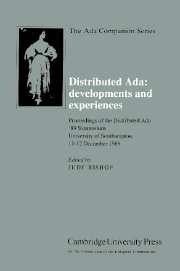 Distributed Ada: Developments and Experiences
Distributed Ada: Developments and Experiences Book contents
- Frontmatter
- Contents
- Preface
- Distributed Ada – the Issues
- Distributed Ada – a Case Study
- Parallel Ada for Symmetrical Multiprocessors
- The York Distributed Ada Project
- From DIADEM to DRAGOON
- Honeywell Distributed Ada – Approach
- Honeywell Distributed Ada – Implementation
- Ada for Tightly Coupled Systems
- A Pragmatic Approach to Distributed Ada for Transputers
- Distributed Ada on Shared Memory Multiprocessors
- The MUMS Multiprocessor Ada Project
- A Portable Common Executable Environment for Ada
- Supporting Reliable Distributed Systems in Ada 9X
The MUMS Multiprocessor Ada Project
Published online by Cambridge University Press: 13 October 2009
- Frontmatter
- Contents
- Preface
- Distributed Ada – the Issues
- Distributed Ada – a Case Study
- Parallel Ada for Symmetrical Multiprocessors
- The York Distributed Ada Project
- From DIADEM to DRAGOON
- Honeywell Distributed Ada – Approach
- Honeywell Distributed Ada – Implementation
- Ada for Tightly Coupled Systems
- A Pragmatic Approach to Distributed Ada for Transputers
- Distributed Ada on Shared Memory Multiprocessors
- The MUMS Multiprocessor Ada Project
- A Portable Common Executable Environment for Ada
- Supporting Reliable Distributed Systems in Ada 9X
Summary
BACKGROUND
Now, when the internal speed of computers is close to the physical limitations of electronic devices cf. [Wil83,Mea83] parallelism is the main way to increase the computing capacity. This conclusion has been obvious for quite some time now, and multiprocessor systems have attracted much attention during the last years.
In order to achieve parallelism, new computer structures and internal organizations are needed. There are, however, still no general solutions to those problems. Finding general and efficient ways to organize for parallelism in computer systems is one main interest of computer architecture research today.
One application of multiprocessors that is likely to increase rapidly is based on the use of parallel languages. As parallel languages has not been generally available, there is still very little knowledge among software designers how to take advantage of program parallelism. Now, when parallel languages like Ada are becoming readily available, the programming community will take advantage of the new possibilities they offer.
There are strong reasons to believe that parallelism in programming will be used even aside from the possibilities of increasing the speed with parallel hardware. Many computational problems have an inherent parallelism that obviously will be used when only parallelism has become part of the programmers' daily life. This will also increase program understandability [Hoa78]. Real-time programming is an obvious example for which these arguments are relevant, but as experience grows the same will show to be true for a variety of application areas.
- Type
- Chapter
- Information
- Distributed Ada: Developments and ExperiencesProceedings of the Distributed Ada '89 Symposium, University of Southampton, 11–12 December 1989, pp. 235 - 258Publisher: Cambridge University PressPrint publication year: 1990
- 2
- Cited by
